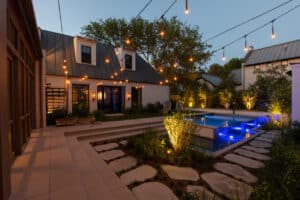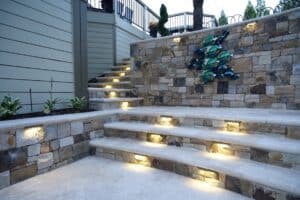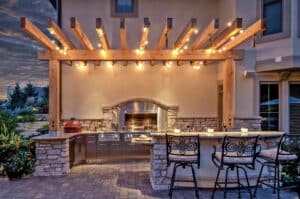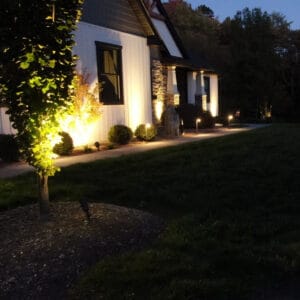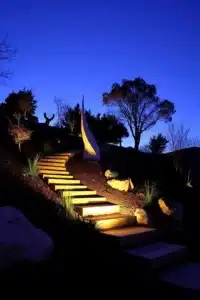Ever walked through a neighborhood at night and noticed how some yards just pop with perfectly placed lights, while others feel like a dimly lit maze? It’s not magic—it’s all about spacing. Getting your landscape lighting solutions spaced just right can transform your outdoor space from average to jaw-dropping, boosting curb appeal and making your home safer to navigate after dark. If you’ve ever wondered, “How far apart should I place my landscape lights?” you’re in the right place. By the end of this article, you’ll have expert tips to nail your lighting layout like a pro, tailored for middle-aged homeowners in the United States who love sprucing up their yards.
Let’s dive into the nitty-gritty of landscape lights spacing and uncover some insider tricks to make your outdoor oasis shine.
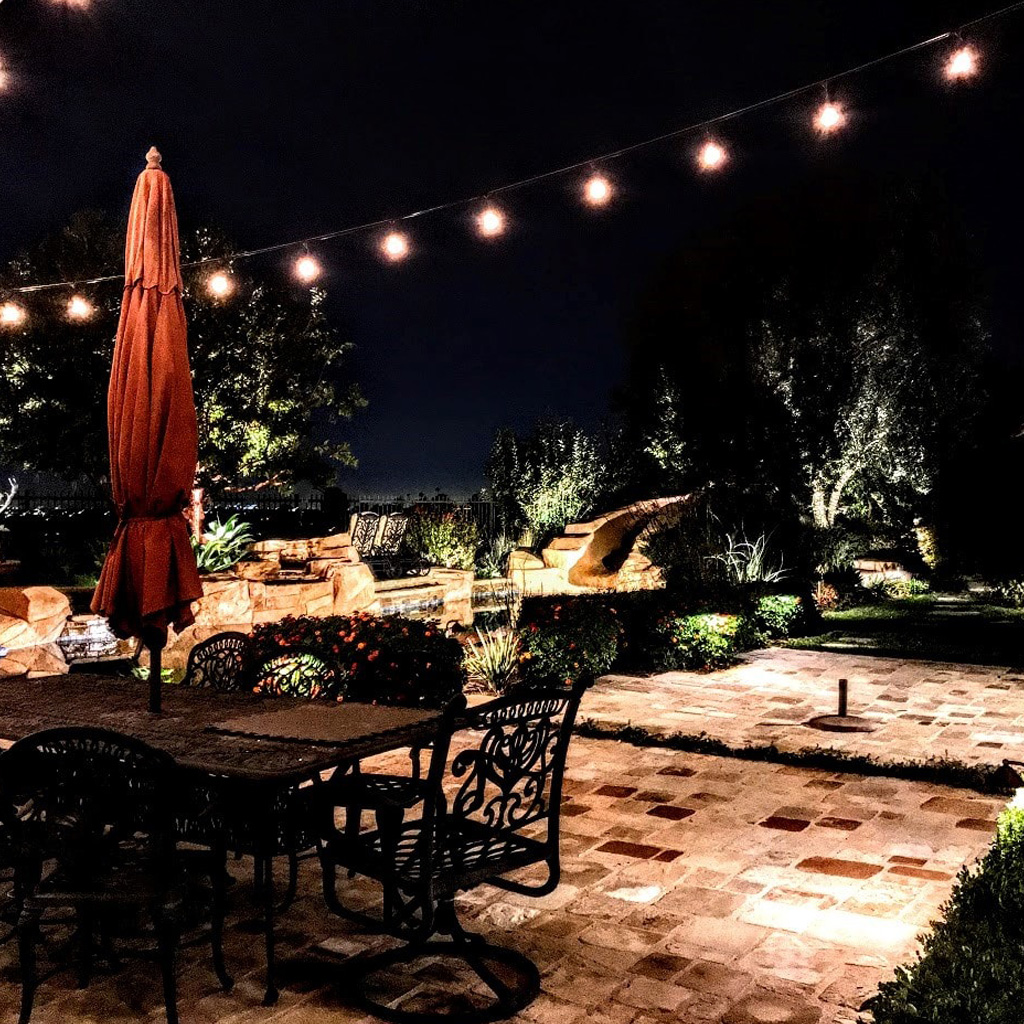
Why Spacing Matters More Than You Think
Think of landscape lighting as the seasoning on your favorite dish—too little, and it’s bland; too much, and it’s overwhelming. Proper spacing ensures your lights highlight your yard’s best features without turning it into an airport runway. It’s about balance: enough light to guide your steps, accent your garden, or show off that gorgeous oak tree, but not so much that it drowns out the charm.
For homeowners like you, this isn’t just about aesthetics. Well-spaced lights can increase safety by illuminating pathways and steps, while also adding value to your property. According to the home builders’ insights, outdoor lighting is one of the top features buyers look for in a home. So, let’s get it right. Want to dig deeper into the benefits of great lighting? It’s worth a peek.
General Rules for Landscape Lights Spacing
Before we get into specifics, here’s a golden rule: there’s no one-size-fits-all answer. The ideal spacing depends on the type of light, its purpose, and your yard’s layout. That said, here are some expert starting points to guide you.
Pathway Lights
These are the workhorses of outdoor lighting, lining walkways and driveways. Space them 6 to 8 feet apart for a smooth, even glow. Too close, and you’ll waste energy; too far, and you’ll leave dark patches that could trip up guests (or you, after a long day). Aim for overlap—each light’s beam should just touch the edge of the next one’s.
Accent Lights
Want to spotlight a tree, statue, or your prized rose bush? For smaller features (under 10 feet tall), place accent lights 3 to 5 feet apart. For larger trees or walls, stretch it to 10 to 15 feet, depending on the beam spread. The trick? Step back at night and adjust until the light flatters the feature without washing it out. Check out some tree uplighting tricks for more ideas.
Deck or Step Lights
These keep your outdoor hangout safe and stylish. Mount them 4 to 6 feet apart along railings or every other step on stairs. This spacing ensures enough light to see where you’re going without turning your deck into a stage spotlight. Curious about why deck lighting rocks? It’s a game-changer.
Here’s a quick reference table to keep handy:
| Light Type | Recommended Spacing | Best For |
|---|---|---|
| Pathway Lights | 6–8 feet | Walkways, driveways |
| Accent Lights | 3–15 feet | Trees, shrubs, focal points |
| Deck/Step Lights | 4–6 feet | Stairs, railings, patios |
Factors That Change the Game
Now, those numbers aren’t set in stone. Your yard’s unique quirks—like size, terrain, and even the brightness of your lights—play a big role. Let’s break it down.
Light Brightness (Lumens)
Brighter lights (higher lumens) cast wider beams, so you can space them farther apart. A 100-lumen pathway light might need 6 feet, while a 200-lumen one could stretch to 8 or 10. Check your fixture’s specs—Tru-Scapes offers low-voltage landscape lighting that balances brightness and efficiency perfectly for homeowners like you. The lighting pros’ standards can shed more light on lumens if you’re curious.
Beam Angle
Lights with narrow beams (think 15–30 degrees) focus tightly, so you might need them closer together for even coverage. Wider beams (60 degrees or more) spread light farther, letting you space them out more. Test this at night with a flashlight to get a feel for it.
Yard Size and Shape
Got a sprawling lawn? You might lean toward the higher end of the spacing range. Tight on space? Stick to the lower end. Curved paths or uneven ground might call for tweaking—add an extra light where shadows creep in.
Purpose
Are you lighting for safety, beauty, or both? Safety-first setups (like along a walkway) need tighter spacing. If you’re just accenting your favorite garden nook, you can be more flexible.
Expert Lighting Tips for Perfect Placement
Ready to take your landscape lights spacing to the next level? These pro tips will help you avoid common pitfalls and make your yard the envy of the block.
Start with a Plan
Grab a notebook and sketch your yard. Mark where you want lights—pathways, trees, patios—and measure the distances. This beats guessing in the dark (literally). Tru-Scapes’ low-voltage systems, part of our lighting lineup, are easy to adjust, so don’t stress if you tweak it later.
Test at Night
Here’s a secret pros swear by: set up your lights temporarily and check them after sunset. Walk around, squint, and see what works. Too bright? Space them farther. Too dim? Pull them closer. It’s like trying on clothes—fit matters. Learn more about installing lights the right way to nail this step.
Layer Your Lighting
Don’t rely on one type of light. Combine pathway lights with accent lights for depth. For example, space pathway lights 7 feet apart along your walkway, then add an accent light 5 feet from your favorite shrub. This creates a polished, professional look.
Avoid Overkill
More isn’t always better. Overcrowding lights can make your yard feel harsh and waste electricity. Stick to the “less is more” vibe—highlight what matters most and let the shadows add mystery. The energy efficiency tips from the DOE back this up.
Think About Maintenance
Place lights where you can reach them easily for cleaning or bulb swaps. Spacing them too far into dense bushes might look great now but be a headache later.

Common Questions About Landscape Lights Spacing
You’re not alone in wondering about this stuff. Here are answers to FAQs I hear all the time from homeowners like you.
How many lights do I need for my walkway?
Measure the length and divide by your spacing (say, 7 feet). A 35-foot path might need 5–6 lights. Round up if it’s curvy or has steps.
Can I mix different light styles?
Absolutely! Pair sleek pathway lights with bold accent fixtures—just keep spacing consistent within each type for a cohesive feel.
What if my yard slopes?
Add an extra light or two where the ground dips to avoid dark spots. Test it out to see what feels right.
Bringing It All Together
So, how far apart should you place landscape lighting solutions? It boils down to this: 6–8 feet for pathways, 3–15 feet for accents, and 4–6 feet for decks or steps, adjusted for brightness, beam angle, and your yard’s personality. Start with these baselines, test at night, and tweak until it’s just right. You’ll end up with a setup that’s safe, stunning, and uniquely yours. Need help picking the right lights? We’ve got you covered.
Ready to light up your outdoor space? Share your plans in the comments—I’d love to hear how it goes! Or, if you’re itching to get started, check out our lighting lineup at tru-scapes.com. Your yard deserves to shine—let’s make it happen.

